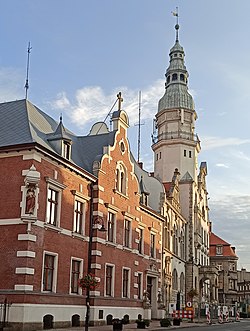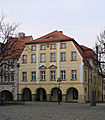Kamienna Góra
Kamienna Góra | ||
|---|---|---|
 Town hall | ||
|
Car plates DKA | | |
| National roads | ||
| Voivodeship roads | ||
| Website | http://www.kamiennagora.pl | |
Kamienna Góra [kaˈmʲɛnːa ˈɡura] (German: Landeshut, Czech: Lanžhot or Kamenná Hora; Silesian: Kamiynnŏ Gōra) is a town in south-western Poland with 18,235 inhabitants (2023). It is the seat of Kamienna Góra County, and also of the rural district called Gmina Kamienna Góra, although it is not part of the territory of the latter (the town forms a separate urban gmina).
Kamienna Góra on the Bóbr river is situated in Lower Silesian Voivodeship between the Stone Mountains and the Rudawy Janowickie at the old trade route from Silesia to Prague, today part of the National Road No. 5. It lies approximately 95 kilometres (59 miles) south-west of the regional capital Wrocław.
History

The area was part of the
During the
From 1871 the town formed part of Germany. The town was not destroyed during
During World War II, the Germans established and operated a subcamp of the Gross-Rosen concentration camp.[2] Around 1,600 men, mostly Poles, and also smaller groups of other ethnicities, were imprisoned and used as forced labour in the subcamp, and many of them died.[11] There was also a forced labour camp for Jews.[12] It was captured by the Soviets on 9 May 1945, and after the war it became again part of Poland.[2] According to the Potsdam Agreement the German populace was expelled and the town was repopulated by Poles, expellees from former eastern Poland annexed by the Soviet Union and settlers from central Poland.[2] Initially renamed to the 19th-century Polish name Kamieniogóra,[13] in 1946 the name Kamienna Góra, which was first recorded in 1249, was adopted.
From 1975 to 1998, it was administratively located in the Jelenia Góra Voivodeship.
Sights
The main historic district of Kamienna Góra is the Old Town (Stare Miasto) with the Freedom (Plac Wolności), Grunwald Squares (Plac Grunwaldzki) and Brewery (Plac Browarowy) Squares, filled with numerous historic buildings. Among the historic sights of Kamienna Góra are:
- Gothic churches of Saints Peter and Paul and Corpus Christi
- Baroque Church of Our Lady of the Rosary
- Town Hall
- Weaving Museum (Muzeum Tkactwa)
- Lower Silesian Rehabilitation Center (Dolnośląskie Centrum Rehabilitacji)
- Culture Centre (Centrum Kultury)
- ZUS office
- preserved medieval town walls
- ruins of the Grodztwo Castle
- numerous historic townhouses and buildings, incl. the train station, tax office, high school, courthouse, etc.
There are also several monuments dedicated to the victims of the local branch of the Nazi German Gross-Rosen concentration camp.
Cuisine
The officially protected traditional food of Kamienna Góra, as designated by the Ministry of Agriculture and Rural Development of Poland, is the kamiennogórski ser pleśniowy (Kamienna Góra blue cheese).[14]
Gallery
-
Kamienna Góra withKarkonoszemountain range
-
Town Hall
-
Weaving Museum (Muzeum Tkactwa)
-
Lower Silesian Rehabilitation Center
-
Gothic Church of Saints Peter und Paul
-
Baroque Church of Our Lady of the Rosary
-
Culture Centre
-
Architectural decorations of one of the old townhouses
-
ZUS office
-
High school (Liceum ogólnokształcące)
-
Train station
-
Grodztwo Castle ruins
-
Memorial to murdered prisoners of the local branch of the Nazi German Gross-Rosen concentration camp
-
Sacred Heart of Jesus Church
-
Courthouse
Notable people
- Carl Gotthard Langhans (1732–1808), architect, designer of the Brandenburg Gate
- Walter Arndt(1891–1944), zoologist
- Viktor Hamburger (1900–2001), biologist
- Rudolf Hamburger (1903–1980), architect and spy
- Gosia Dobrowolska (born 1958), actress
- Damian Dąbrowski (born 1992), Polish professional footballer
Twin towns – sister cities
Kamienna Góra is twinned with:[15]
 Bitterfeld-Wolfen, Germany
Bitterfeld-Wolfen, Germany Dvůr Králové nad Labem, Czech Republic
Dvůr Králové nad Labem, Czech Republic Ikast-Brande, Denmark
Ikast-Brande, Denmark Trutnov, Czech Republic
Trutnov, Czech Republic Vierzon, France
Vierzon, France Wolfenbüttel, Germany
Wolfenbüttel, Germany
References
- ^ "Population. Size and structure and vital statistics in Poland by territorial division in 2019. As of 30th June". stat.gov.pl. Statistics Poland. 2019-10-15. Retrieved 2020-02-14.
- ^ a b c d e f g h "Historia". Starostwo Powiatowe w Kamiennej Górze (in Polish). Retrieved 9 February 2020.
- ^ Łaborewicz, Ivo (1989). "Kamiennogórskie epizody wojenne z lat 1345 i 1348 a recepcja antyku na Śląsku". Rocznik Jeleniogórski (in Polish). Vol. XXVII. Jelenia Góra. p. 93.
- ^ Łaborewicz, p. 94
- ^ a b Łaborewicz, p. 96
- ^ ISSN 0080-3480.
- ^ Kisiel, pp. 116–119
- ISSN 0080-3480.
- ^ Pazgan, p. 89
- ^ a b c Pazgan, pp. 90–91
- ^ "Subcamps of KL Gross- Rosen". Gross-Rosen Museum in Rogoźnica. Retrieved 10 September 2020.
- ^ "Zwangsarbeitslager für Juden Landeshut". Bundesarchiv.de (in German). Retrieved 10 September 2020.
- ^ Rymut, Kazimierz (1987). Nazwy miast Polski (in Polish). Ossolineum. p. 99.
- ^ "Kamiennogórski ser pleśniowy". Ministerstwo Rolnictwa i Rozwoju Wsi - Portal Gov.pl (in Polish). Retrieved 11 November 2023.
- ^ "Współpraca z zagranicą – Miasta partnerskie". kamiennagora.pl (in Polish). Kamienna Góra. Retrieved 2020-02-28.

















